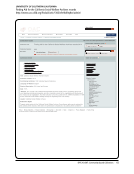64 · Survey Results: Survey Questions and Responses
Working with veterans. Working with community groups and making the collection accessible to interested groups.
Working with the materials themselves.
48. Please briefly describe up to three challenges of managing this community-based collection. N=35
Collection continues to grow and therefore makes demands on available space and staff time. Newer formats of
organizational record keeping (i.e., digital records and web-based records) challenge our abilities.
Community members are not familiar with archival practices, which can cause conflicting assumptions. Community
members have high expectations for staff time and investment. Students need additional training to work with
these collections.
Complete development of digital repository.
Dedicated staff time to increase research and holdings. Budget and resource allotment. Building and storage
space resources.
Financial sustainability. Balancing investments in this single area of intense growth and interest with other
library priorities.
Getting Omeka ready to accept community-donated content. Reaching out to people with diverse perspectives of the
event. Curating the content.
High expectations of the community, coupled with low financial support .High expectations of the university
coupled with low financial support. Infighting within the community.
Housing large community-based collections is challenging. Cataloging these collections can take longer than expected,
if not resourced. Promotion of the collections can be problematic with limited staff.
Increased interactions/staff time responding to questions from donors. Need to manage ongoing additions to collection.
Increased demands to promote collection, i.e., exhibits.
Integrating community views into a broader/objective academic setting. Educating community on best practices in
Libraries, and material handling. Community communications: adapting former practices and evolving emotional
attachment of community to the collection often clouds reasonable decision making.
It keeps growing and needs to be reprocessed.
Lack of interest from the ASA. Irregular deposit of materials. Archival processing.
Lack of local language expertise to continue with processing of donated materials.
Lack of resources. High and various expectations from the members of the community.
Language. Processing previously unorganized records.
Maintaining an up-to-date collection register/finding aid. Managing copyright on legacy collections.
Need for additional staff time to process the collection. Need for increased shelf space to house additions to
the collection.
Need to continue to work with organization to continue to acquire more records.
Working with veterans. Working with community groups and making the collection accessible to interested groups.
Working with the materials themselves.
48. Please briefly describe up to three challenges of managing this community-based collection. N=35
Collection continues to grow and therefore makes demands on available space and staff time. Newer formats of
organizational record keeping (i.e., digital records and web-based records) challenge our abilities.
Community members are not familiar with archival practices, which can cause conflicting assumptions. Community
members have high expectations for staff time and investment. Students need additional training to work with
these collections.
Complete development of digital repository.
Dedicated staff time to increase research and holdings. Budget and resource allotment. Building and storage
space resources.
Financial sustainability. Balancing investments in this single area of intense growth and interest with other
library priorities.
Getting Omeka ready to accept community-donated content. Reaching out to people with diverse perspectives of the
event. Curating the content.
High expectations of the community, coupled with low financial support .High expectations of the university
coupled with low financial support. Infighting within the community.
Housing large community-based collections is challenging. Cataloging these collections can take longer than expected,
if not resourced. Promotion of the collections can be problematic with limited staff.
Increased interactions/staff time responding to questions from donors. Need to manage ongoing additions to collection.
Increased demands to promote collection, i.e., exhibits.
Integrating community views into a broader/objective academic setting. Educating community on best practices in
Libraries, and material handling. Community communications: adapting former practices and evolving emotional
attachment of community to the collection often clouds reasonable decision making.
It keeps growing and needs to be reprocessed.
Lack of interest from the ASA. Irregular deposit of materials. Archival processing.
Lack of local language expertise to continue with processing of donated materials.
Lack of resources. High and various expectations from the members of the community.
Language. Processing previously unorganized records.
Maintaining an up-to-date collection register/finding aid. Managing copyright on legacy collections.
Need for additional staff time to process the collection. Need for increased shelf space to house additions to
the collection.
Need to continue to work with organization to continue to acquire more records.
























































































































































































